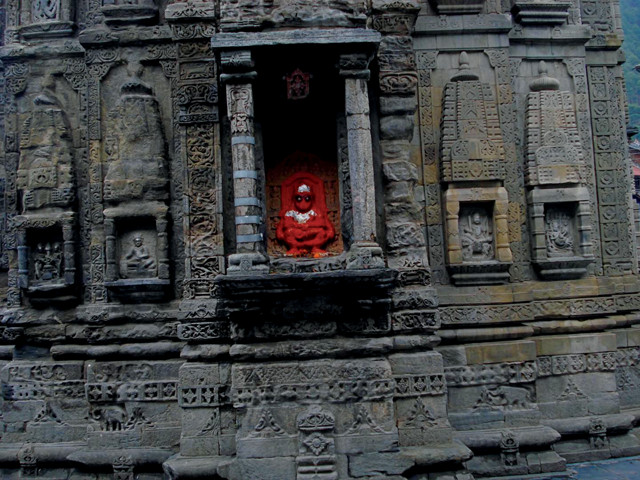
by Mary Caperton Morton Tuesday, November 15, 2016

This leaning pillar at the Lakshi Narayan temple in Chamba, India, has been clamped to prevent further collapse. It may have been damaged during the 1555 earthquake. Credit: Mayank Joshi.
The Himalayan Mountains have not been raised gently. The ongoing collision between India and Asia that has uplifted the highest mountain range on Earth is punctuated by large earthquakes. But one region in the northwest Himalaya, known as the Kashmir seismic gap, has remained eerily quiet, save for a magnitude-7.8 event in 1905, and a mysterious quake in 1555. Now, a new study looking at damaged temples in the Chamba district of Himachal Pradesh in India, within the seismic gap, is shedding some light on the two historical quakes.
“Ancient buildings can tell us about the paleoearthquake history of an area and the intensity of past shaking,” says Mayank Joshi, a paleoseismologist at the Wadia Institute of Himalayan Geology in Uttarakhand, India, and lead author of the new study, published in Seismological Research Letters. To better constrain the range of rupture and extent of damage wrought by the 1555 and 1905 events, Joshi and co-author V.C. Thakur, also at the Wadia Institute, examined seventh-century temples near two towns within the seismic gap, Chamba and Bharmour.
The team surveyed the ancient buildings for damage, such as tilted pillars, displaced rooftops, upwarped stone floors, and cracked bricks or foundation blocks. Because the temples are so old, the researchers had to distinguish damage caused by aging and subsidence from that caused by earthquakes. “Aging of an archaeological structure is caused by atmospheric agents like wind, rain and changing temperature with time,” Joshi says. “There is no internal deformation due to [long-term] stresses acting on the body of the structure.”
Joshi and Thakur then compared the damage they found to historic records of the 1555 and 1905 earthquakes to determine which of the earthquakes were more likely to have caused the damage. The distribution of damages indicated that the Chamba temples were possibly affected by the 1555 earthquake, while the Bharmour temples were likely damaged only by the 1905 quake.
Their findings may extend the rupture zones for the 1555 earthquake. Little is known about this event, which is mentioned somewhat cryptically in historical texts and may have had a magnitude as high as 7.6. The epicenter is thought to have been in the Srinagar Valley about 200 kilometers northwest of Chamba, but the level of damage to the temples suggests the fault may have ruptured farther to the southeast than previously thought.
The Chamba temples do not appear to have been damaged by the 1905 quake, however, suggesting that the section of fault underlying the Kashmir seismic gap has remained quiet for the last 461 years. “This area has not experienced any major earthquakes since 1555, and may have enough potential energy stored to produce a great earthquake in the future,” Joshi says.
Not everyone agrees with their findings, however. Drawing conclusions from very old buildings, especially temples that are important for worship and are typically repaired and maintained over time, can be difficult, says Roger Bilham, a geophysicist at the University of Colorado Boulder, who was not involved in the new study.
“I am skeptical of their basic assumption that the damage they found must have been caused by the 1555 earthquake,” Bilham says. “Most of these temples were constructed with unknown foundation quality and tilting is expected after 500 years of settling.” So the study’s reliance on tilted pillars and other structures is troubling, he says. “I do not believe tilted features have anything to do with ground shaking. After the Gorkha earthquake struck Katmandu last year, buildings weren’t tilted. They either fell down or stayed where they were.” Archaeoseismology can be a useful tool in piecing together the earthquake history of a region, Bilham says, but it needs to be done very carefully — more quantitatively.
Joshi and Thakur plan to continue their work surveying the many ancient temples, buildings and monuments in the region for clues to better define the area’s earthquake history.
© 2008-2021. All rights reserved. Any copying, redistribution or retransmission of any of the contents of this service without the expressed written permission of the American Geosciences Institute is expressly prohibited. Click here for all copyright requests.